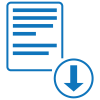Fillable Form Balance Sheet
A Balance Sheet, also known as a Statement of Financial Position, is a financial statement indicating the assets, liabilities, and equity of a business.
Fill and sign Balance Sheet online and download in PDF.
What is a Balance Sheet?
A Balance Sheet is a part of financial statements, usually issued by a company to its requester as a financial report. It contains the financial information of a company at a specific time, including its records of assets, liabilities, and stockholders’ equity.
Transparency is essential in building a trustworthy relationship within and outside the company. Using a Balance Sheet, it is easier to track your company’s worth to understand its financial status. Also known as the Statement of Financial Position, it presents what your company owes and owns.
How to fill out a Balance Sheet?
Get a copy of Balance Sheet template in PDF format.
To fill out a Balance Sheet, determine the type of form your company needs.
The following initiatives will lead you to a smooth-sailing process.
- Know your reporting date and period.
- List down your assets.
- Distinguish your liabilities.
- Compute your stockholders’ equity.
In this case, you are filling out a Vertical Balance Sheet.
Lines 1. Company Name
Enter your company name.
Line 2. Address
Enter your company address.
Line 3. Date
Enter the reporting date or period of your balance sheet.
Page 1. Assets
You may write the amount of the listed assets on their corresponding lines. Notice the differences between Current and Non-Current assets as mentioned above.
Current Assets:
Cash on Hand. Accessible cash (either actual or in your bank account)
Cash on Bank. Petty cash (coins or notes)
Accounts Receivable. Proceeds of your company from your customer’s payments
Allowance for Bad Debts. Valuation account to estimate the number of your uncollectible receivables
Inventories. Collection of your company’s finished goods
Supplies. Consumables your company use in production
Prepaid Expenses. Future expenses paid in advance
Other Current Assets
Enter the amount of other current assets.
Total Current Assets
Enter the total amount of all your listed Current Assets.
Non-Current Assets:
Notes Receivable. Record sheet of the value of promissory notes
Furniture & Fixture. Movable items or tangible assets of your company (chairs, tables, etc.)
Accumulated Depreciation - F&F. Value of your F&F based on their lifespan
Property, Plant & Equipment. Assets of your company that are hardly liquidated
Accumulated Depreciation - PPE. Value of your PPE based on their lifespan
Other Non-Current Assets
Enter the amount of other non-current assets.
Total Non-Current Assets
Enter the total amount of all your listed Non-Current Assets.
TOTAL ASSETS
Add the total Current and Non-Current Assets and enter the amount.
Page 2. Liabilities and Equity
You may write the amount of the listed liabilities and equity on their corresponding lines. Take note of the differences between Current and Non-Current liabilities as mentioned above.
LIABILITIES
Current liabilities:
Accounts Payable. Short-term debts of your company
Taxes Payable. Your company’s unpaid government liabilities
Salary Payable. Funds you owe your employee with
Rent Payable. Unpaid rent
Unearned Revenue. The money you had received for a service that has yet to provide
Accrued Expenses. Prerecorded expenses of your company (salary or wage)
Other Current Liabilities:
Enter the amount of other current liabilities.
Total Current Liabilities:
Add the total Current Liabilities and enter the amount.
Non-Current Liabilities further explanation:
Long-Term Debts. Debts that aren’t due within a year
Bond Payable. Bonds issued by large corporations
Loan Payable. The remaining balance of your company (bank loans and such)
Other Non-Current Liabilities
Enter the amount of other non-current liabilities.
Total Non-Current Liabilities
Add the total Non-Current Liabilities and enter the amount.
TOTAL LIABILITIES
Add the total Current and Non-Current Liabilities and enter the amount.
EQUITY
Capital. Your company’s funds (cash or financial assets)
Additional Paid-in Capital. Value of share capital
Retained Earnings. Your company’s left income after paying dividends to shareholders
Other Equity
Enter the amount of other Equity.
TOTAL EQUITY
Enter the amount of total equity.
TOTAL LIABILITIES AND EQUITY
Add the total Liabilities and Equity and enter the amount.
Start filling out a Balance Sheet sample and export in PDF.
Frequently Asked Questions About a Balance Sheet
How does a Balance Sheet help a company?
Companies, whether small or large, shall provide a Balance Sheet to document their fiscal statements. This way, they can evaluate their assets and liabilities during a period of time. Thus, they can distinguish their financial strengths and weaknesses and come up with relevant policies or solutions.
Furthermore, a Balance Sheet can be a directory in case of financial conflicts.
How to balance a Balance Sheet?
Upon getting the total amount of Assets, Liabilities, and Equity, you will see if your Balance Sheet is balanced. The accounting equation for this is Assets = Liabilities + Equity. Your company Assets should be equal to the sum of your Liabilities and Equity.
Your Balance Sheet should always balance for you to determine your company’s financial health. If it is uneven, then there must be a problem. If your Assets appear to be greater than the sum of your Liabilities and equity, it means your company has a strong financial status. Your company owns more money than its debts.
What are the types of Balance Sheets?
There are four types of Balance Sheets.
- Classified Balance Sheet. This format shows the entity’s information into classified subcategories of accounts, such as assets, liabilities, and shareholders' equity. Considering large numbers, having the data aggregated makes it more readable.
- Common Size Balance Sheet. This sheet provides a column for the relevant percentages that correspond to total assets, liabilities, and equity accounts.
- Comparative Balance Sheet. To compare your company’s financial position, you may issue a comparative balance sheet. The format itself shows a comparison of monetary reports during multiple periods.
- Vertical Balance Sheet. Among all the forms, this is the simplest presentation of the assets, liabilities, and equity gathered in a singular column.
What are the sections of a Balance Sheet?
- Assets. Assets refer to the possessions of your company that add value to its economic gains. Assets have two categories — current and non-current.
- Current Assets. All your company’s liquid assets that can be exhausted and sold in a standard business within a year are called Current Assets. Examples of these assets are cash, cash equivalents, supplies, etc.
- Non-Current Assets. Non-current assets refer to the illiquid properties of your company. It is a long-term investment, such as equipment, land, or partnership with another company.
- Liabilities. To shorten, liabilities pertain to your company’s financial obligations. It has two categories — current and non-current.
- Current Liabilities. These are the short-term financial debts of your company that are anticipated within a year or in a standard operating cycle. Examples of these are accrued expenses, dividends and account payables, or any short-term debt.
- Non-Current Liabilities. Contrary to the current liabilities, these are the long-term debts that are payable for more than a year. Samples of these include extended loan obligations, bonds payable, and any prolonged debts.
- Equity. After your company liquidates its assets and settles your debts, stockholders get ahold of residual claims. This is called equity.
Is a Journal Entry a Balance Sheet?
No, a Journal Entry and a Balance Sheet are two different financial reports.
A Journal Entry is used to record transactions that occur in an accounting period. While a Balance Sheet is used to summarize the account balances in the ledgers at a specific point in time.
An accounting period can span from a day to several weeks, depending on your business. For example, some businesses use a calendar year as their accounting period, while others might have a 52-week fiscal year.
How long does it take to finalize a Balance Sheet?
Typically, a Balance Sheet is finalized after the end of an accounting period. The exact time varies depending on your organization and the complexity of the financial reports you are producing.
Once a Balance Sheet is complete, it can be distributed to various individuals within your company, including management, employees, and stakeholders.
How do I calculate a Balance Sheet?
To calculate a Balance Sheet, you will need to create a list of all the assets in your possession, then add them together. You will also list all liabilities and equities and add each amount together to get your overall Balance Sheet total.
You may use this accounting equation:
Assets = Liabilities + Equity
Is a Balance Sheet the same as a Profit and Loss Statement (P&L)?
No, a Balance Sheet and a Profit and Loss Statement are two different financial statements.
A Balance Sheet summarizes the account balances in your company’s ledgers, while a Profit and Loss Statement shows how much money your business has made or lost over a specific period of time.
Most businesses produce both a Balance Sheet and a P&L Statement each month, depending on their accounting periods, to track their flow of cash in and out.
How does cash flow factor into a Balance Sheet?
Cash is considered an asset, and if you have more cash than your liabilities, the difference will show up on the statement as equity. If you owe more than you have in cash, this amount will be reflected as a liability on a Balance Sheet.
Cash inflows and outflows are called cash flows. Your business can have a positive or negative cash flow, depending on whether you bring in more money than you spend throughout your accounting period.
What is the difference between assets and liabilities?
Assets are anything that shows a monetary value and can be sold to someone else. Assets include any profitable intangible or tangible items your business owns, such as cash, equipment, furniture, inventory, and accounts receivable.
Liabilities are any expenses or debts your business acquired in a certain time period. Liabilities include accounts payable, salaries payable, credit card debts, and bank loans.
Assets and liabilities are two factors to determine the financial stability of your business.
Why are liabilities not expenses?
Liabilities go beyond a year or more in most cases, while expenses are associated with a specific time period.
The liabilities section of your Balance Sheet provides an entire breakdown of what you owe to others and what you need to pay out in the future. While some liabilities can be short-term, most liabilities will remain on your Balance Sheet for at least a year, making them not technically an expense.
Expenses are listed in the Income Statement section of your Balance Sheet to show how much money was spent in a specific time period or accounting cycle.
Why do I need an Income Statement to prepare a Balance Sheet?
Your company's Income Statement is essential when creating a Balance Sheet because it provides you with the information you need to prorate your assets and liabilities. You use the information from your Income Statement to tally up and allocate your expenses and liabilities on a monthly basis.
An Income Statement allows you to track your expenses, which can better help you find any accounting mistakes that could lead to an unbalanced Balance Sheet.
What will I find on the liabilities portion of a Balance Sheet?
The liabilities portion of your Balance Sheet includes numbers that indicate how much your company owes. If you have debts, loans, or interest-bearing accounts, these will all be included in the liabilities section.
Income tax payable is also included in this area of your Balance Sheet since it may take a while before your company pays this expense off.
What are the classifications of liabilities?
The classification of your Balance Sheet liabilities depends on how long that liability will last. Liabilities are classified as short-term and long-term.
- Short-term Liabilities — Short-term liabilities are any liabilities that must be paid off within a year or less. Payable accounts, taxes payable, and wages payable are all considered short-term liabilities since they will generally need to be settled in the next accounting period.
- Long-term Liabilities — Long-term liabilities are any balances that need to be paid off by the end of the fiscal year. Loans and mortgages fall under this category since these payables will not need to be settled until at least one full accounting period has passed.
A complete Balance Sheet must contain both short-term and long-term liabilities, but the amount recorded for each may vary depending on your company’s accounting procedures.
How often is a Balance Sheet updated?
A Balance Sheet is a vital snapshot of your company’s financial situation on one specific date. Since a Balance Sheet is updated monthly, quarterly, or yearly, balances will often differ from one Balance Sheet to another.
You may update or prepare a Balance Sheet whenever you want if it is for a specific purpose. If a Balance Sheet is created to provide evidence of financial solvency or performance, then you should update your data on or around the date when a new fiscal year begins.
If you update your Balance Sheet monthly or quarterly, be sure to take into account any changes in your company’s financial situation that may have occurred during the time between updates.
What are the classifications of assets?
Assets are classified as current, non-current, tangible, and intangible.
- Current Assets — Current assets are any assets that can be easily converted into cash within a year. Cash, accounts receivable, and inventory are all considered current assets since they will need to be sold or used before the end of a fiscal year.
- Non-current Assets — Non-current or long-term assets are any items that cannot be converted to cash within one year. Land, buildings, and equipment fall under this category since these items will need to be used for an extended period of time before they can be liquidated.
- Tangible Assets — Tangible assets are those that come together as a whole unit. Tangible assets include any cash or inventory on hand as well as all other current and non-current assets that can be easily measured and determined.
- Intangible Assets — Intangible assets are any items that cannot be touched, seen, or physically measured. Goodwill and patents fall under this category since they do not have a physical presence in the company’s Balance Sheet.
Why is a Journal Entry used in preparing a Balance Sheet?
One of the basic precepts in accounting is that a transaction must be recorded simultaneously. For example, when you prepare an Income Statement for a particular time period, many transactions have occurred during that time period, and it is not sufficient to look at only the most recent one. Many events will have occurred earlier, such as expenses that were incurred in the past but were not paid yet. In other words, a complete historical record will be beneficial to prepare a Balance Sheet at a given point in time because the material from many different transactions should be considered.
A Journal Entry is necessary for keeping track of all financial transactions for an accurate Balance Sheet.
Is salary an asset?
Salary is not an asset. An asset is anything that has value and can be either sold or used in the course of business operations. Thus, salary is not an asset as it only has value to the employee and company itself.
Is capital an asset?
No, capital is not an asset.
While capital is necessary for a business to operate, it is not considered an asset since it is used to generate revenue during normal operations. For instance, you were starting a new company and raised money through debt or equity financing. You may have capital but could not technically put that money on your Balance Sheet as an asset since doing so would be misleading to your Balance Sheet’s true financial status.
Does the IRS look at a Balance Sheet?
Yes, the Internal Revenue Service views Balance Sheets as one of the most important financial statements companies are required to file. The IRS uses a Balance Sheet to determine a company's profit and losses and financial position at any given time for tax, insurance, and other laws the IRS enforces.
Companies must complete Balance Sheet reports and submit them to the Internal Revenue Service. One of the IRS forms C corporations must file is Form 1120, U.S. Corporation Income Tax Return, which requires a complete Balance Sheet that has been prepared and approved by the board of directors.
Who prepares a Balance Sheet?
A Balance Sheet is prepared by an accountant, bookkeeper, figurer, and other finance professionals.
Because a Balance Sheet is used to determine the financial status of a business, accuracy is critical. Many businesses hire independent auditors to prepare or review their Balance Sheets.
If you are a small business owner who would like to create your own Balance Sheet, it is very important that you understand all of the line items you are including. Your Balance Sheet will be used to determine whether or not your company can make interest payments on its debt obligations. It will also be used when you apply for loans, during mergers and acquisitions, or in conjunction with your Income Statement to help you decide about where to allocate resources. All information you provide on your Balance Sheet should be presented in the most accurate manner possible.
Can a Balance Sheet have no liabilities?
Yes, a Balance Sheet can have zero liabilities. In such a case, the equity would be equal to the total asset.
Having no liabilities on a Balance Sheet may indicate a start-up company with a lot of assets. A start-up company may not have had the time or resources to accumulate any debt since it first began generating revenue.
A zero-liability Balance Sheet can also indicate a company that is about to go out of business. If a company cannot earn enough money to pay its debts, it may be forced to close. When this happens, it is likely the company will try to settle as many debts as possible. However, if a company succeeds in settling all of its liabilities, its Balance Sheet would have no liabilities.
How is a Balance Sheet used in financial modeling?
A Balance Sheet is a vital part of financial modeling. It provides a snapshot of a company's assets, liabilities, and equities as of a specific date. These details are used to aid in financial valuation analysis to determine the value of a company from its Balance Sheet data alone.
In addition, a Balance Sheet can be used as an input for other financial models. For instance, if you were creating a debt repayment model, you can use a Balance Sheet to determine how much cash is available at any given time.
What is a good Balance Sheet?
A good Balance Sheet is one that accurately represents the financial status of a company. Assets should be greater than liabilities, and equities should be positive at all times.
If a company has too many liabilities on its Balance Sheet, it can struggle to obtain additional funding, or it may have trouble meeting existing debt obligations. If there are not enough assets, a company may have trouble meeting its current expenses.
A balanced Balance Sheet, where the total amount of assets is equal to the total amount of liabilities and equities, presents a company in the most favorable light and makes it easier for stakeholders and other interested parties to make decisions. When a Balance Sheet is balanced, it indicates that there is no problem with the company and that its financial position will likely remain consistent in the future.
Why is my Balance Sheet not balanced?
There are several reasons why your Balance Sheet may not be balanced, such as:
- Your Balance Sheet may be unbalanced due to an accounting mistake or error in your Cash Flow Statement. If this happens, you should correct the error and re-run your financial statements until the numbers line up properly.
- You may have assets that are not recorded on your Balance Sheet. For instance, you might have some assets that you do not own personally but are still considered useful to your business. These assets include the furniture in an office building or factory floor, even though they may be owned by a third party.
- You may have liabilities that are not accounted for on your Balance Sheet. For instance, if you have a business partner and he or she has promised to pay part of your debt but has not kept this promise, the full liability would be listed as yours on his or her Balance Sheet. You should catch any such discrepancies that go unrecorded and fix them as soon as possible.
- If your company is growing fast, you may not see much of an imbalance until the growth has slowed down. For instance, if your business grew by $1 million in one year but produced no revenue or profit for this growth period, you would likely record all $1 million as expenses on your Balance Sheet for that year because it does not produce any cash. When growth slows, you will see your Balance Sheet begin to balance because the expenses will no longer be great enough to prevent cash from coming in.
- Selling or buying some of your assets can also change how imbalanced your Balance Sheet is. These are considered non-cash transactions that are not recorded on your Cash Flow Statement, so they do not affect your cash balance. In some cases, non-cash transactions can affect the overall value of your assets and make it seem as if you have more or less total assets than liabilities.
Essentially, if your calculations are correct and still reflect an imbalance, it may simply mean that your company is not yet generating enough cash to pay its liabilities. You may need to wait for more revenue or get a loan from a bank to cover the costs of your liabilities until you have collected enough money from sales.
Must a Balance Sheet always balance?
Yes, a Balance Sheet must always balance. In other words, the total amount of assets always has to be equal to the total amount of liabilities and equities.
The name "Balance Sheet" itself implies that the sheet must balance. When a Balance Sheet does not balance, it indicates a mistake or missing information in your financial statements. You should correct the error and re-run your financial statements until the numbers line up correctly to verify that you have all of your expenses and liabilities represented on your Balance Sheet.
A Balance Sheet must always balance because your company's financial position is only as strong as its weakest point. If there are not enough assets to cover all of your company's liabilities, you are at risk of bankruptcy.
Create a Balance Sheet document, e-sign, and download as PDF.
Related articles:
Keywords: balance sheet balance sheet template statement of financial position balance sheet pdf fillable form report form balance sheet pdf
















